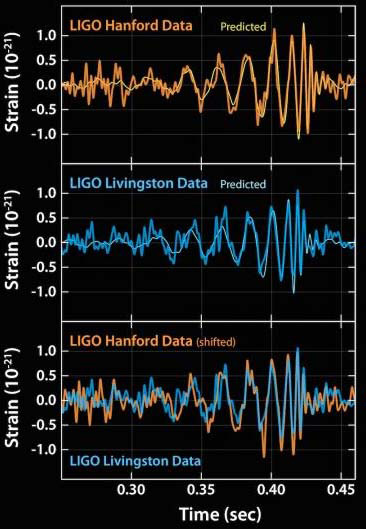|
Joan
and I were visiting Antarctica when we heard the great news. Even at
the End of the Earth, the splash of gravity waves reached us. But the
Internet is glacially slow in Antarctica; only after getting home could I
read all the juicy details.
On
Feb. 11, 2016, LIGO, the Laser Interferometer Gravitational-Wave
Observatory, announced the first-ever direct observation of gravity
waves. These particular waves came from the merger of two black holes
1.3 billion light-years (8 billion, trillion miles) away.
This
is a momentous discovery. It confirms what Einstein predicted 100 years
ago. It rewards hundreds of physicists who devoted their careers to
finding gravity waves. It vindicates the NSF’s largest-ever single
investment ($620M).
And most importantly, observing gravity waves creates a new “telescope” to explore the universe.
So what are gravity waves?
We
are all familiar with ocean waves that go up and down, and guitar
strings that wave left and right. Gravity waves are more complex. They
simultaneously wave up-and-down and left-and-right, as they move in the
third dimension, the dimension perpendicular to up-down and left-right.
Einstein
explained that all massive objects, particularly stars and black holes,
“bend” space and time. This is a bit like placing a bowling ball on a
bed sheet: the ball bends the sheet. If two bowling balls spin around
one another on a bed sheet, the sheet’s shape continuously changes, and
“ripples” flow outward from the center, as shown below.

This analogy provides some idea of how gravity waves move through space.
Einstein
said gravity waves move at the speed of light, and as they do, space is
alternately stretched and compressed. And as space distorts, so
does everything that it contains, including Earth, LIGO, and us.
Unfortunately,
gravity waves created in remote galaxies are incredibly tiny by the
time they reach us. This is why the search for gravity waves has been in
vain for 50 years, and why LIGO’s success is so sweet.
With
its latest upgrades completed in September 2015, LIGO can now detect
the largest gravity waves, ones that change Earth’s distance to the Sun
by at least 1 billionth of the thickness of a dime. (How LIGO
accomplishes this great feat is the subject of another newsletter.)
For
gravity waves moving into the screen, this graphic shows the variation
over time of: (1) the wave distortion factor; (2) the shape of Earth;
and (3) the length changes in the two perpendicular arms of LIGO.

As
the graphic shows, at one moment (time 2), space stretches up-and-down
and compresses left-and-right, and later (time 4), those distortions
reverse — space compresses up-and-down and stretches left-and-right.
LIGO precisely measures changes in the difference between the lengths of
its two arms.
But
as it turns out, even LIGO’s extraordinary precision isn’t good enough.
LIGO is so sensitive that it detects ocean waves crashing on a
coastline 300 miles away. Even vibrations from trucks on nearby highways
swamp gravity waves from other galaxies.
To
ensure length changes have extraterrestrial causes, we have two LIGOs:
one near Hanford, Washington and another near Livingston, Louisiana.
Only when both LIGOs detect a signal, can we be confident it is a gravity wave.
The
graphs below show what both LIGOs detected on September 14, 2015. The
orange curve is from Hanford, and the blue curve is from Livingston.
Also shown are two thin curves that are the predictions of Einstein’s
theory for two merging black holes whose masses are 29 and 36 times the
mass of our Sun. The predictions match the data so well that these thin
curves are extremely hard to see — sorry.

As
the lower graph shows, the two signals match extremely well when the
Hanford signal is advanced by 0.007 seconds. This means the gravity wave
hit Livingston 0.007 seconds before hitting Hanford.
From
this time difference, we can estimate the gravity wave’s direction of
motion. It came roughly from the direction of the Large Magellanic Cloud
galaxy, but from almost 8 times farther away. On a cosmic scale, that’s
still in our “time zone”.
With
a few more LIGOs spread across the globe, we could pinpoint the origin
of each gravity wave — we could create a gravity-map of the universe,
just as we now have a light-map of the universe.
Every
time scientists have developed a new instrument for observing the
universe, a new “telescope”, we have made tremendous discoveries.
Gravity
can reveal what light cannot. Light cannot penetrate dust clouds
surrounding galaxy centers, nor can light reveal our universe’s early
years.
The
Caltech website says that, for a few tenths of a second, this merger of
two black holes captured by LIGO released 50 times more energy than all
the stars and galaxies in the entire universe. Yet, our conventional
telescopes saw nothing because black holes do not emit light.
Many
other interesting phenomena also emit no light, including dark matter
and dark energy. Dark matter comprises 26% of all the energy in our
universe, and dark energy comprises 69%. All the stars, galaxies, and
other “normal” matter that light reveals amount to less than 5%.
It’s time to “see” the other 95%.

Best Regards,
Robert
March 1, 2016
Note: Previous newsletters can be found on my website.
|